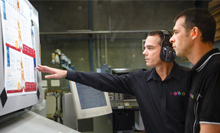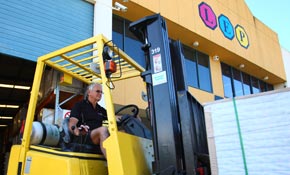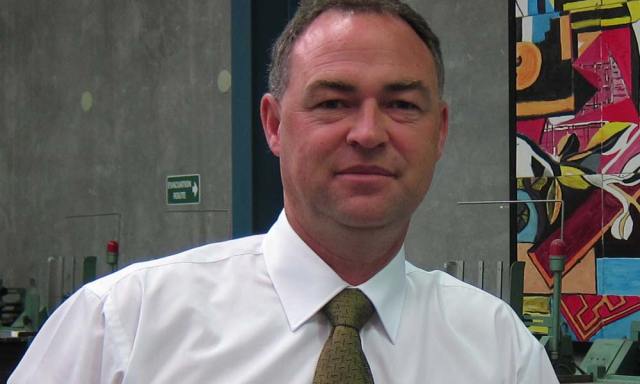
Printers, on the whole, can be a paranoid bunch. The most wary will clam up at the most innocuous question. Some are more open, happy to talk shop but even they generally draw the line at reveal anything about their customers. ProPrint comes up against this cautiousness on a regular basis, so we can only imagine the balancing act faced by the trade printer. Here is a fellow printer who not only understands what types of work you sell, but might have a fair idea how much you sell it for and – shock horror – who you sell it to.
Being sensitive to a printer’s sensitivities is a cornerstone of the ethos at Queensland-based LEP Colour Printers. The principle is discretion; confidentiality is so paramount it may as well be written above the door. In a way it is: nowhere on the façade does the external branding use the word ‘print’.
This was a conscious decision, says chief executive John Bromfield. “The signage does not say ‘printers’. We don’t work with local businesses unless they are on-sellers of print; we actually screen them and turn them away.”
Turning away potential customers might seem counter-intuitive in these tight times, but Bromfield’s team is not about to chase a quick buck at the expense of the hard-earned trust of its client base. “We are proud of the fact that we are a trade-only printer, and strenuously protect this position. It is important to our customers and it is important to us.
“LEP’s business is printing: fast, quality and seamless. We respect our customers and want them to look good by supplying a quality printed product, on time and at competitive price. The printed job is only one part of the print supplier relationship that they have with their customers.
“Our customers also need security that we won’t take a predatory position as regards their customer base, and with LEP they have this and can work in confidence that LEP is working with them to grow their business,” he says.
“Hence, all new customers are screened and vetted before they are given access to our online ordering system. To do this we complete an online ATO check of their ABN, confirm they are a print reseller, and monitor the work they put through.”
So if you don’t make a crust by selling print, you can stop reading now. LEP doesn’t want your business. But as long as you pass that test, the company will welcome you with open arms – and its broad base of around 3,000 customers is testament to the fact that this company is the printer’s printer.
Its clients span a diverse range of printers and graphic arts operators across the country. A quick sticky-beak around the boxes sitting in the LEP despatch bay shows the kinds of mum-and-dad-type companies that make up the bulk of the printing industry.
Putting aside the consolidated groups and a few $20m-plus companies, very few players have the expertise or equipment to be the 100% in-house one-stop shop that customers might like. This is where LEP steps in, producing specialist work for printers across the country and, increasingly, across the region.
“Our core customer base is across Australia, however, because of our fast turnaround times, we also have customers across the Tasman in New Zealand, and further afield into Asia. Our vision is to become Australasia’s leading provider of low-cost, high-quality printing solutions with the fastest turnaround time to the printing trade,” says Bromfield.
There’s still work to be done. But the LEP story is one of continued growth. It started life in 2001 as a private enterprise under the stewardship of owner Mike Brooks, based in the sea change hub of the Sunshine Coast. The company slowly but surely carved out a strong position in the trade printing sector over the next seven years. In 2008, Brooks, looking to retire, sold the business to the private equity arm of ANZ Bank. It was at this time that Bromfield took over, bringing a perspective from outside of the industry. He hasn’t got ink in his veins but he does have a manufacturing pedigree, and is “big on process and procedure” (this systematic approach is a theme that will come up many times during ProPrint’s interview).
With Bromfield installed as CEO, the 27-staff firm followed a route of expansion to bring the workforce over 40 by 2011.
Growth plan
It’s hard to have a platform for growth when you’re bursting at the seams, and until very recently, LEP had well and truly outgrown its home. So Bromfield orchestrated the next phase in its evolution. It is moving across town from its site in Warana to Forest Glen, closer to the regional hub of Maroochydore. The relocation will roughly triple its footprint to 2,200m2 and give it “the opportunity to expand and gain greater production efficiencies”. This brings obvious wins, like moving from its current production sprawled across two buildings interweaved with staircases – not the ideal layout for a company that has a philosophy of efficiency, efficiency, efficiency.
Beyond the efficiency must-haves, the new home will also offer some nice-to-haves, such as Bromfield’s decision not to install pallet racking in the paper storage area. Instead, all stocks will be kept at ground level. This plan isn’t so difficult due to the fact LEP has a very limited range of stocks and hence a fairly small paper store. Having pallets on the floor will speed up the workflow. Not needing a forklift will minimise any safety risks – another Bromfield bugbear.
“We value our staff’s wellbeing and have gone to great lengths to improve the environmental conditions in what is otherwise a very physical business operation. We have invested heavily in implementing a leading-edge workplace health and safety management system as part of our ongoing commitment to our employees,” he says.
This was put the test only recently when the company was at the sharp end of a random audit. Any surprises? No, Bromfield says it was “just another day”. The auditors told them the site was the best they had seen. (This isn’t lip service, as ProPrint finds out when we barge across the yellow lines on the factory floor to take a photo of a pressman loading plates, and are quickly pulled back into line).
WH&S also makes sense from an efficiency point of view. At LEP, productivity is embedded in the principles of lean manufacturing. The company has worked with a number of outside agencies in the past to implement lean policies. It brought in manufacturing specialist QMI Solutions, which is a joint venture between the Queensland Department of Employment, Economic Development and Innovation, the Department of Education and Training, University of Queensland and the Queensland University of Technology. According to its mission statement, “QMI Solutions is dedicated to improving the skills, performance, innovation and capability of the Queensland manufacturing industry”.
At LEP, it brought to bear the Manufacturing Microscope initiative, which benchmarks a company’s performance against other businesses. LEP is also undergoing level two of the PIAA’s Sustainable Green Print program.
When Bromfield looks at the factory floor, he sees a well-oiled machine. “Trade printing is akin to a jobbing workshop; I bring a lot of manufacturing experience to the business in terms of world’s best practice operating methodologies, which promote efficiency and drives operating cost down, savings that can in turn be passed on to customers in the form of low everyday prices.”
Forget traditional media – for all intents and purposes, this is an online business. Production is underpinned by its ‘LEP Online’ ordering system, which operates alongside the Agfa Apogee workflow. The systems are all proprietary, designed and developed by LEP with a combination of in-house and external expertise.
Technology backbone
“Using technology is very important for efficiencies. When dealing with the kinds of volumes we are, you rely on very sophisticated technology. LEP Online is the backbone of our company,” says Bromfield.
The system is still relatively new, having been launched in 2009. Before then, ordering was done in a more traditional – and less efficient – manner.
“Prior to 2009, orders were placed by email and manually inputted into LEP’s production system. While we had a file upload facility on our website, customers would also save their artwork to disc and send it to us by normal mail. We basically had to double handle every order matching specifications with artwork files; obviously, this was very slow and created inefficiencies.
“LEP Online is the face of LEP; its e-commerce interface has enabled us to manage customer orders efficiently with them entering orders directly into our production process. This has enabled LEP to provide even quicker turnaround times to our customers and a higher quality service. One of the new features of LEP Online is detailed job tracking, which enables customers to see their job at every point of production process, with the actual time displayed,” says Bromfield.
Work comes through the internet portal and is pulled into Apogee and set on its pair of Agfa Avalon CTP machines. The ganged jobs are sent to the shop floor to roll off the company’s pair of four-colour A1 Ryobi presses. It is finished in a bindery that includes folders, guillotines, celloglazers and an eight-station collator-stitcher-trimmer.
The online system is still a work in progress, in as much as the company continues to bolt on new features. The latest innovation is to integrate it with the freight management systems of a number of logistics companies, such as Star Track Express and Fastways. It is another step toward a more “lights out” ordering and production approach, essential for speed and, of course, low costs.
How low, you ask? Well, we can tell you. When it comes to prices, the trade printer is different to the typical commercial house. Where the average printer keeps pricing close to his chest, LEP happily hands out its price list to trade customers.
Open book prices
The move toward this transparent approach came from previous owner Mike Brooks. LEP’s general manager, Rob Walters, who has worked under both the past and present regimes, says it wasn’t a decision taken lightly. “It was fairly revolutionary when the previous owner published the price list,” he says.
Bromfield adds: “It is open book. Our prices are all market-driven based upon ganging efficiencies, which means we can set and maintain the lowest prices for our most popular range. In addition, we are always looking at ways to improve production efficiencies so that cost savings can be passed on to our customers.”
Business cards are the most common products, but the company also offers brochures, flyers, stationery, A1-size posters and even magazines. The most popular products are 400gsm gloss front and 400gsm matt double-sided business cards, priced at a mere $40 for 1,000. “Printers can put 100-200% margins on our products,” says Bromfield.
Speed is the other USP at LEP, and it recently backed this up with a promise of a 30-hour turnaround time on business card orders. It works because the business model is focused on a slim range of collateral that can be ganged and printed with the minimum of human involvement. It’s a bit like Henry Ford famous quote: “You can have any colour as long as it’s black,” says Bromfield.
LEP is a little more flexible than the automobile inventor: it also offers cyan, magenta and yellow, but there’s nothing beyond this: no spots, no PMS colours.
“Our customers would not come to us [for non-standard work] because they know we don’t do it. But we do listen to our customers. If a customer comes to us with a specific product request, we listen. We introduced 300gsm business cards because of this.”
Within the limited range of products, it is also up to the customer to ensure that work is up to scratch. As part of its ‘trade-only’ exclusivity, LEP does not have any design resources on site,
just pre-press. There are no fix-ups or tweaking the artwork.
Fewer hands on deck
This is how LEP keep prices so low: by taking out the costs of manpower. There are no reps on the road or account handlers manning the phones. This makes the make-up of the factory somewhat different to the typical print shop. Bromfield can’t offer any real comparison on how LEP differs from the typical commercial house – because he doesn’t come from a print background – but Walters can, having notched up 30 years in print.
“The biggest difference is the volumes. Commercial printers are doing major
runs with the client. They will have a team of reps and customer executives. They typically have larger jobs but a lower volume of jobs. A commercial printer will print anything. We are a lot narrower,” says Walters.
But in the tough trading climate, printers have been pushed toward the door marked ‘diversification’, and LEP has the technology in place that could easily be turned toward commercial work. Bromfield knows full well that any change of direction outside of LEP’s trade print specialism would be a risky manoeuvre and not one he is considering.
“There are people who say they are a trade printer and are not. We are not going to change track.
“It is not the avenue for us. It flies in the face of what our customers say is important to them. It would be shortsighted to go down that path. We guard the ‘trade-only’ mentality,” adds Bromfield.
factfile
Based – Sunshine Coast, Queensland
Established – 2001
Headcount – 40
Presses – Two A1 four-colour Ryobis
Floor space – 2,200m2
Comment below to have your say on this story.
If you have a news story or tip-off, get in touch at editorial@sprinter.com.au.
Sign up to the Sprinter newsletter



